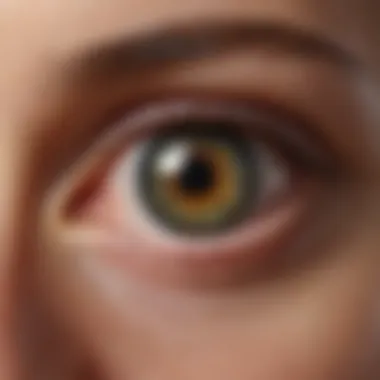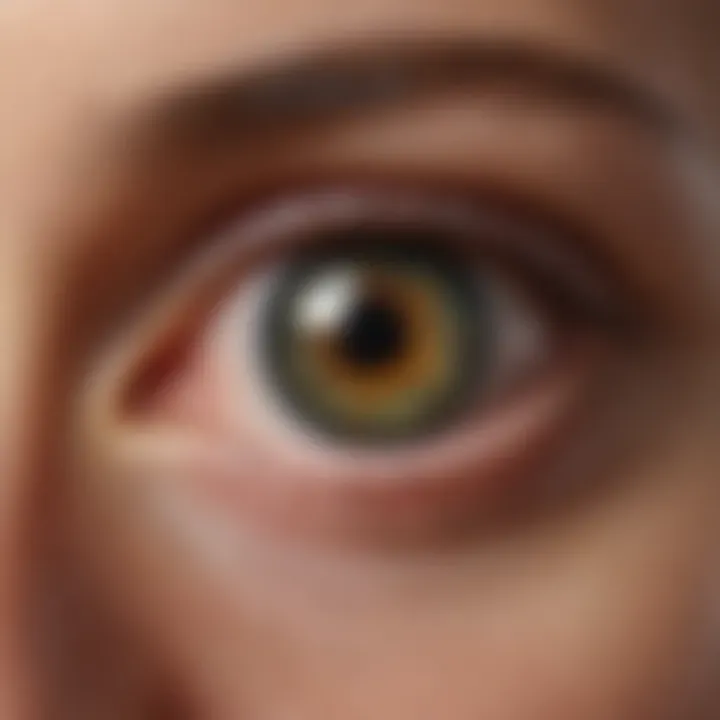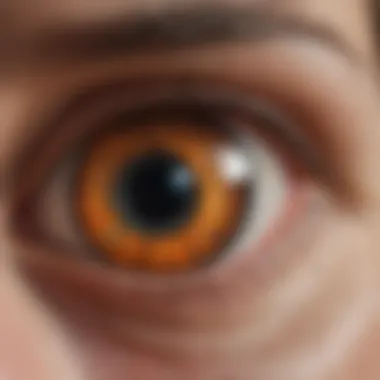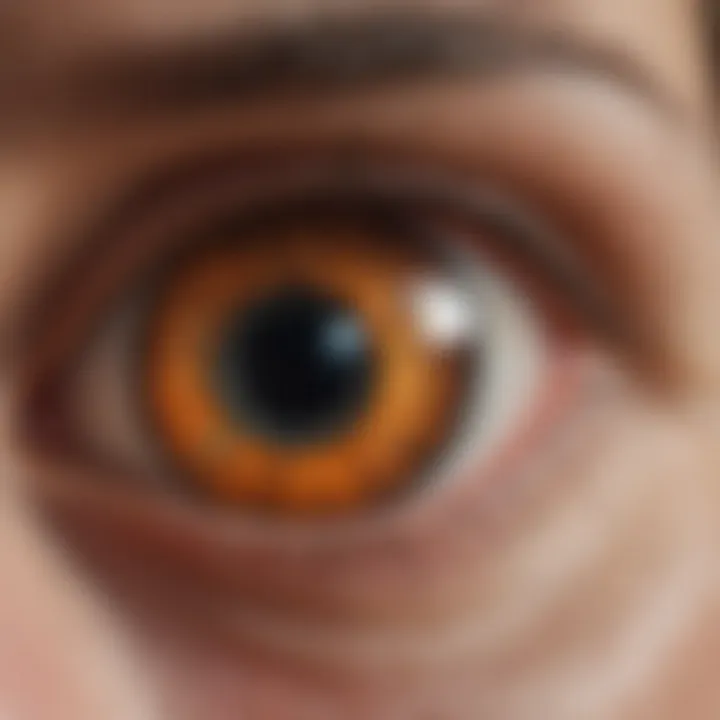Understanding Visual Experiences in Retinitis Pigmentosa


Intro
Retinitis pigmentosa (RP) often represents a gradual and relentless retreat from the vividness of life, making understanding its implications on visual perception crucial. Individuals with RP navigate a landscape marred by deteriorating vision, which carries a myriad of challenges—both visible and hidden. This piece shines a light on those unique visual experiences, where every stage of vision loss tells a story of adaptation, resilience, and sometimes despair.
Article Overview
Purpose of the Article
This article aims to peel back the layers of complexity surrounding visual experiences in individuals grappling with retinitis pigmentosa. It moves beyond the clinical definitions and statistics, seeking to connect with the reader on a personal level. By providing both a statistical and experiential view, the discussion expands into how people cope, adjust, and redefine their interactions with the world.
Relevance to Multiple Disciplines
The implications of understanding RP extend across various fields:
- Healthcare professionals can enhance patient care by grasping the emotional and psychological impacts of vision loss.
- Educators can develop inclusive teaching strategies, tailoring methods to support students affected by RP.
- Psychologists and social workers may find insights that inform counseling approaches, fostering empathy and understanding.
- Researchers have a broader framework to examine potential therapies and intervention strategies.
Research Background
Historical Context
For centuries, retinitis pigmentosa has been shrouded in confusion and misdiagnoses. Historically, conditions resembling RP were often labeled as mere night blindness. It wasn't until advancements in genetics and ophthalmology in the late 20th century that clear characterization began to form. By dissecting this disorder, researchers have unraveled the underlying genetic factors, confirming that RP encompasses a variety of mutations leading to gradual retinal degeneration.
Key Concepts and Definitions
Understanding RP requires familiarity with some key terms:
- Rod and cone cells: These are the photoreceptors in the retina responsible for light perception and color vision.
- Visual field: Refers to the total area visible at one time, which can diminish significantly.
- Color perception: In RP, this often deteriorates, making it difficult for individuals to distinguish between colors.
With these foundational concepts in place, we can delve deeper into the experiences of those living with retinitis pigmentosa. As we navigate through this article, the goal is to cultivate a comprehensive understanding of the visual experiences in RP, which is not just about the loss of vision but also about the adaptation of life to make the best of what remains available.
Understanding Retinitis Pigmentosa
Understanding Retinitis Pigmentosa is essential in grasping the broader implications of this retinal condition. It sheds light on how the disease unfolds, the varying degrees of vision impairment it brings, and the impact on individuals' daily lives. A nuanced grasp of this subject helps caregivers, healthcare professionals, and affected individuals themselves to navigate the complexities associated with the disorder.
Collating knowledge regarding the types of RP, its genetic factors, and prevalence will not only serve as a guiding light for effective management approaches but will also draw attention to the importance of research and awareness surrounding visual disorders.
Definition and Overview
Retinitis Pigmentosa (RP) refers to a group of inherited retinal diseases. It's characterized by a progressive degeneration of photoreceptor cells in the retina, primarily affecting the rod and cone cells responsible for vision in low light and color differentiation, respectively. Many individuals will start experiencing night blindness first, eventually leading to a gradual loss of peripheral vision.
The condition varies significantly among individuals, with some experiencing a slower progression, while others may face a more rapid decline in vision. The wide range of symptoms can also complicate the diagnosis, as initial symptoms may be mistaken for other visual impairments.
Types of Retinitis Pigmentosa
Understanding the different types of retinitis pigmentosa enriches our comprehension of how the disorder behaves in various populations. Each type has unique genetic underpinnings and clinical features.
Autosomal Dominant RP
Autosomal Dominant Retinitis Pigmentosa (ADRP) tends to present with a milder form of the disease. One key characteristic is that only one copy of the mutated gene is necessary to manifest the condition. This means that if a parent has ADRP, there is a 50% chance for each offspring to inherit the condition. Its prevalence among RP types makes it a significant focal point in studies and discussions.
A unique feature of ADRP is the potential for individuals to retain functional vision into later stages of life. However, late onset is common, meaning that symptoms may not manifest until adulthood, which can sometimes delay diagnosis. This aspect highlights awareness-raising as a crucial element in tackling RP effectively.
Autosomal Recessive RP
In contrast, Autosomal Recessive Retinitis Pigmentosa (ARRP) typically requires both parents to pass on a mutated gene for a child to be affected, thus resulting in a higher carrier rate within the population. The principle characteristic of ARRP is its varied onset, with some experiencing symptoms in childhood while others only find out later in life.
The unique aspect of ARRP is its association with other retinal conditions, which may complicate the clinical picture. This variability can create challenges for early diagnosis and treatment options. This unpredictability underscores the importance of genetic counseling for families who may have histories of RP.
X-Linked RP
X-Linked Retinitis Pigmentosa (XLRP) primarily affects males, as the gene is located on the X chromosome. Females can be carriers but usually display less severe symptoms due to the presence of a second X chromosome. The defining characteristic is an earlier onset and rapid progression compared to other types of RP. Males may exhibit night blindness in their early teens and face significant visual impairment by their twenties.
A unique feature is the consistent genetic mutation associated with XLRP, which has been the subject of significant study. While the prognosis can often be more concerning for those affected, advances in therapies offer hope. Understanding XLRP provides crucial insights into targeted treatment and potential genetic interventions.
Prevalence and Genetic Factors
The prevalence of Retinitis Pigmentosa is estimated to be about 1 in 4,000 individuals. Genetic variations contribute significantly to this statistic, as it often runs in families. About 50-60% of RP cases are attributed to mutations in specific genes, with many being inherited in various patterns, including autosomal dominant, autosomal recessive, and X-linked fashions.
Understanding these genetic factors is pivotal in developing awareness, informing treatment pathways, and providing adequate support for affected individuals. The scope of RP’s prevalence highlights the necessity for further research, genetic counseling, and community support mechanisms to assist those impacted.
The Pathophysiology of Retinitis Pigmentosa
Understanding the pathophysiology of retinitis pigmentosa (RP) is essential for grasping how this condition impacts the visual experiences of those affected. This section serves as the backbone of the article by illuminating the intricate mechanisms at play within the retina, which ultimately shapes the daily lives of individuals with RP. By diving deep into the biological processes responsible for retinal decay, readers can appreciate the complexity of the disease, its effects on visual function, and the ongoing efforts to innovate treatment strategies.


Mechanisms of Rod and Cone Cell Deterioration
Retinitis pigmentosa primarily targets photoreceptor cells in the retina, specifically rods and cones. Rods, responsible for low-light vision, and cones, which handle color and detail in bright light, are critical for everyday sight. The deterioration of these cells originates from genetic mutations that impair their survival and function. Over time, this leads to progressive vision loss.
Common mechanisms behind this deterioration include:
- Genetic Mutations: Many forms of RP are linked to genetic anomalies which affect proteins that are vital for the health and maintenance of photoreceptors. Specific mutations in genes like RHO or USA lead to dysfunctional retinal cells.
- Cellular Stress Responses: The loss of function in photoreceptors can trigger a cascade of cellular stress responses. These stress responses often result in inflammation and apoptosis, pushing the demise of the already fragile cells.
- Accumulation of Toxic Metabolites: As rod and cone cells fail, the byproducts of their metabolic processes can accumulate, worsening the decline of neighboring cells.
Each of these elements contributes to the complex cascade that characterizes RP, leading to the gradual loss of vision.
Impact on Retinal Function
The impact of RP on retinal function is profound and multi-faceted. As the disease progresses, the complex interplay among various retinal cells, including retinal ganglion cells and bipolar cells, becomes disrupted. This results in a cascade of visual impairments that those with RP often face.
Key impacts include:
- Night Blindness: Rod cells, which deteriorate first, lead to difficulties seeing in low-light conditions, famously known as night blindness.
- Narrowing of Visual Field: The loss of peripheral vision often begins as a gradual decline but can quickly progress into significant visual field constriction, forming what is commonly referred to as "tunnel vision."
- Color Perception Changes: As cone cells fail, individuals may start to lose their ability to differentiate between similar colors, impacting their interaction with the world.
This broad spectrum of consequences emphasizes just how drastically RP reshapes visual capabilities and daily experiences.
Role of the Retinal Pigment Epithelium
The retinal pigment epithelium (RPE) plays a supportive yet crucial role in maintaining photoreceptor health and function. Situated between the retina and the choroid, the RPE provides essential nutrients and helps in the recycling of visual pigments. In RP, the RPE can become compromised as photoreceptors fail. Here’s how the RPE contributes to the challenges faced by individuals living with RP:
- Support Functions: The RPE helps transport vitamins and other nutrients necessary for photoreceptor survival. When rods and cones degrade, the RPE may struggle to replenish these nutrients effectively.
- Waste Management: One of the functions of the RPE is to manage waste from the photoreceptors. With a failing system, toxic byproducts can accumulate, accelerating retinal degeneration.
- Barrier Defense: The RPE serves as a barrier between the retina and potential harmful blood byproducts. When this barrier is breached, further damage can ensue, complicating the visual experiences of those affected.
Visual Characteristics in Retinitis Pigmentosa
The visual characteristics in retinitis pigmentosa (RP) offer a critical examination of how this condition uniquely impacts vision. Understanding these aspects helps in fostering empathy and awareness for individuals affected by RP. Many may not recognize how this disease deeply influences daily life, especially regarding the specific visual deficits it creates. In highlighting the elements like night blindness, loss of peripheral vision, and progression into tunnel vision, we gain clarity on the practical challenges that accompany such debilitating changes.
Night Blindness
Night blindness, also known as nyctalopia, often presents itself as one of the earliest indicators of retinitis pigmentosa. Individuals may find it increasingly difficult to see in low-light conditions, which can drastically affect their ability to navigate effectively during the evening hours. The discomfort and frustration stemming from this impairment can lead to significant lifestyle adjustments. Picture a once social person who now hesitates to go out after sunset. Night blindness not only restricts physical mobility but also instills a sense of isolation, as many social gatherings tend to take place during later hours.
"It's like walking through fog; everything seems distant, and shadows take on a life of their own."
"It's like walking through fog; everything seems distant, and shadows take on a life of their own."
Such descriptions from personal experiences underline the emotional weight of night blindness. Moreover, this difficulty is attributed to the degeneration of rod photoreceptors, which are responsible for vision in dim lighting. Understanding this characteristic is vital as it shapes the support and interventions that can be implemented for those experiencing these visual and social limitations.
Loss of Peripheral Vision
The loss of peripheral vision follows closely behind night blindness in the progression of RP. This narrowing of the visual field often manifests gradually, leaving those affected unaware of the creeping limitations. Initially, one might notice a slight blur or fading of the peripheries. Over time, this could evolve into a significant visual scotoma where even the simplest activities like crossing the street or recognizing someone from the side become monumental tasks.
The impact includes:
- Safety risks, as individuals may not notice obstacles until they are close, heightening the chance of falls or accidents.
- Social challenges, like feeling self-conscious in crowded areas, where it becomes challenging to maintain awareness of surrounding individuals.
- Cognitive load, as the brain struggles to adjust to a shrinking field of vision, leading to fatigue and frustration during activities that were once second nature.
Understanding this gradual loss isn't just about recognizing the change but also about acknowledging the shift in social dynamics and independence.
Progression of Tunnel Vision
Progression into tunnel vision signifies a more advanced stage of visual impairment. Here, individuals experience a marked constriction of their visual field to a narrow corridor, sometimes resembling looking through a tube. This transition can feel like a slow-motion loss of the world around, where the vibrant details of life fade into shadows. This stage can evoke a profound sense of vulnerability and helplessness, as the affected person realizes the extent of their vision loss and its implications on personal safety and social engagement.
It's important to highlight how this transformation takes a toll on mental health, causing not only physical challenges but also emotional hurdles:
- Anxiety and Depression: The fear of the unknown can loom heavy, leading to feelings of despair and helplessness.
- Need for Additional Support: This prompts a reliance on assistive devices or mobility aids, which may be met with resistance from individuals wishing to maintain independence.
The progression of tunnel vision represents a critical turning point in living with RP; understanding this allows for more tailored support systems, advocacy, and awareness programs that can effectively address these profound changes.
Experiential Accounts of Vision Loss
In the journey of understanding retinitis pigmentosa (RP), hearing from those who live with this condition is paramount. Their stories provide a window into the daily realities faced by individuals dealing with various stages of vision loss. It’s not just about clinical definitions; it is about real-life impacts and adaptations. Experiential accounts help to humanize the condition, revealing the complexity of emotions and strategies that come into play. These narratives illustrate how vision impairment extends beyond the physical—shaping social interactions, mental well-being, and overall quality of life.
Personal Narratives from Individuals with RP
When individuals share their personal narratives, they offer profound insight into the nuances of living with RP. For example, one individual recounted the moment they first noticed difficulty in reading street signs. At first, it felt like a minor inconvenience. However, as the weeks turned into months, this inconvenience transformed into a daily hurdle. Each small change—having trouble recognizing familiar faces or needing more light to read—was a brick wall that slowly built up around them.
These stories often illustrate varied experiences among individuals. Some may experience gradual vision loss, while others face sudden declines. The emotional weight of these narratives is immense, conveying feelings of frustration, vulnerability, and resilience. One woman described learning to navigate life while blind, painting a picture of determination and adaptability.
"It’s like moving through a fog. You know there’s something there, but you can’t quite see it. It tests your strength every day."
"It’s like moving through a fog. You know there’s something there, but you can’t quite see it. It tests your strength every day."


This perspective not only sheds light on the experience of RP but also builds empathy among the readership. The empathy developed from these narratives acts like a bridge, connecting the general public and professionals working in the field with those profoundly impacted by the condition.
Adapting to Changing Visual Capabilities
Adapting to the diminishing visual capabilities is akin to learning a new language. Each eye condition presents unique challenges that necessitate a personal response. One might begin utilizing adaptive strategies such as memorizing routes or relying on tactile cues. A gentleman shared how he memorized the layout of his home, tagging key items by touch to maintain his independence.
Furthermore, support groups are invaluable during this transition. They provide a safe space for individuals to share coping mechanisms, such as using technology to identify objects or navigate unfamiliar environments. Innovation is key, and many individuals find that embracing the latest assistive technologies has greatly enhanced their ability to adapt. Screen readers, voice recognition software, and apps that help identify colors or objects have all made a significant difference in daily tasks.
Social and Emotional Impact
The social and emotional dimensions of living with RP are often overlooked, yet they play a crucial role in the overall experience of the condition. Interactions with peers can become complex; the fear of judgment or misunderstanding can create reluctance to participate in social settings. One account highlighted a young person’s struggle to engage in group activities due to apprehension about navigating public spaces.
The weight of isolation can be heavy, leading to feelings of loneliness and sadness. Many individuals face not just a physical barrier, but also an emotional one, as they grapple with the crushing reality of fading vision. However, the courage many exhibit to continue engaging with their community is inspiring. Support from friends and family becomes essential, acting as an anchor during turbulent times.
Ultimately, understanding the social and emotional impact of vision loss due to RP is critical. It accentuates the need for a stronger support system and greater awareness within the community, fostering an environment where individuals feel seen, heard, and supported in their journey.
Color Perception Challenges
Exploring color perception challenges is crucial in understanding how retinitis pigmentosa (RP) affects individuals not just in their daily lives but also in terms of their emotional well-being. Color is a vital aspect of our visual experience; it informs how we interact with the world. For individuals with RP, alterations in color perception can lead to practical difficulties and a sense of disconnection from their environment. Recognizing the implications of these challenges emphasizes the need for tailored support systems and technologies that can help bridge the gap in visual experiences.
Understanding Color Vision Deficiency in RP
Color vision deficiency in retinitis pigmentosa stems primarily from the degeneration of cone photoreceptors in the retina. While the degree of impairment varies widely among individuals, studies show that most people with RP face difficulty distinguishing between certain colors, particularly those within the red-green spectrum. This occurs because the cones responsible for detecting these colors deteriorate at varying rates depending on the type and progression of the disease.
The impact of this deficiency is multifaceted. Daily tasks, such as choosing clothing, preparing meals, or driving, which usually rely on color recognition, can become daunting. Think of someone needing to read a traffic signal. If they can’t differentiate between red and green reliably, that could lead to serious dangers. Additionally, certain occupations, like graphic design or any field involving color coding, may become difficult or even impossible to pursue.
"The colors we see are like threads woven into the fabric of our experience; losing them feels like losing parts of the very cloth that shapes who we are."
"The colors we see are like threads woven into the fabric of our experience; losing them feels like losing parts of the very cloth that shapes who we are."
Comparison to Normal Color Perception
In contrast to individuals with normal color vision, those with retinitis pigmentosa experience a distortion that can change how they perceive the world. A person with typical vision can easily distinguish vibrant hues and their subtleties, but for those with color vision deficiencies due to RP, colors may become muted or blended, making it hard to enjoy the richness of visual stimuli.
To offer a clearer picture, consider the following comparisons:
- Normal Vision: Individuals can easily differentiate between colors like red, blue, green, yellow, and their combinations, allowing for rich environmental engagement.
- Color Perception in RP: Colors often blend; for example, green and yellow may appear nearly identical, leading to frustration in recognizing ripe fruit or navigating a vibrant landscape.
The distinctions in color perception not only affect the aesthetic appreciation of surroundings but can also carry emotional weight, including feelings of isolation and anxiety. As society becomes increasingly digitized and visually oriented, understanding these differences becomes indispensable, especially for education and community planning.
A deeper insight into color perception variations among individuals with RP invites further dialogue and engagement on how to improve life quality for those affected.
Comparative Visual Experiences
Understanding the comparative visual experiences in retinitis pigmentosa (RP) is crucial as it provides insightful clarity on how diverse these experiences can be across different individuals. Recognizing these variations in visual perception not only enriches the discussion around RP but also highlights the importance of personalized approaches in treatment and support. Furthermore, it fosters awareness of the unique challenges faced by those living with this condition. By grasping the intricacies involved in visual perception from person to person, researchers and practitioners can develop more effective strategies for rehabilitation and adaptation.
Visual Differences Across RP Types
Retinitis pigmentosa is not a one-size-fits-all condition; it manifests differently depending on its genetic makeup. The distinction between various types of RP is paramount, as understanding these differences contributes significantly to managing expectations about vision and adapting coping strategies. For instance, those with autosomal dominant RP may notice vision loss that is slower in progression compared to individuals with X-linked RP, who often experience a more rapid decline.
- Variability Across Gene Mutations - Different mutations can affect the way retinal cells deteriorate, leading to variability in visual symptoms. Gene therapy, promising as it may be, holds the potential to address these specifics on a case-by-case basis.
- Symptoms Onset and Progression - For example, users with variant forms may develop night blindness in their teenage years, while others might not notice issues until their 30s.
- Visual Field Loss - Peripheral vision tends to be affected first, but the timeline significantly differs. Autistic individuals may present wider visual fields for longer, compared to those with more aggressive mutations.
Understanding these nuances helps healthcare providers tailor adaptive strategies more effectively and helps families navigate this complex landscape of vision loss.
Impact of Disease Progression on Vision
Not only do different types of RP present unique visual experiences, but the progression of the disease also substantially alters these experiences over time. As the disease advances, individuals may find their visual abilities gradually retreating, leading to profound changes in daily functioning.
- Gradual Onset - Many discuss that the gradual erosion of visual capabilities impacts not just their eyesight but also their emotional well-being. As they transition from having peripheral vision to experiencing significant tunnel vision, their interaction with the environment changes drastically.
- Social Dynamics - The evolution of vision can significantly impact social interactions. Where once conversations may have occurred during social outings, dimly lit settings can now prove to be overwhelming for individuals experiencing progressive vision loss. This shift might lead to withdrawal from previously enjoyed activities.
- Psychological Adaptation - Adapting to these changes becomes crucial. People often need to develop methods to navigate their world anew, from using verbal cues to seeking tactile experiences.
The journey through RP brings not only a change in physical ability but cultivates resilience and adaptability.
The journey through RP brings not only a change in physical ability but cultivates resilience and adaptability.
These experiences highlight the need for education and communication surrounding the impact of RP progression. It allows for a more empathetic approach in discussions about daily living and the emotional ramifications that come with declining vision, which can support both individual and community well-being.
Understanding these comparative visual experiences equips communities, caregivers, and individuals themselves with the knowledge needed to create supportive environments, ultimately enriching life for those affected by RP.
Research and Advances in Understanding RP
The field of research surrounding retinitis pigmentosa (RP) has witnessed notable strides in recent years, spurring hope for affected individuals. With ongoing investigations, scientists have cultivated a deeper grasp of the disease's mechanisms and potential interventions. Embracing this knowledge is pivotal, not just for medical professionals or researchers but for patients and their families seeking clarity in the face of uncertainty. Progress in understanding RP holds the promise of creating targeted therapies and improving the quality of life for those impacted.
Current Therapeutic Approaches


Modern medicine reflects an evolving landscape of therapies aimed at managing RP. Although a definitive cure remains elusive, several approaches have surfaced that seek to alleviate symptoms and enhance functionality. Often, these therapies focus on either slowing the progression of the disease or maximizing the remaining visual capability. Some emerging treatments include:
- Vitamin A supplementation: Some studies suggest that vitamin A might slow down the degeneration of rod photoreceptors, although the outcomes vary significantly among individuals.
- Pharmacological interventions: Key compounds are being explored to preserve retinal cells and protect remaining vision. For instance, the use of an antioxidant called EPO (erythropoietin) has shown promise in laboratory models.
- Visual prosthetics: Devices such as retinal implants are being developed, which can partially restore vision by directly stimulating the remaining functional retinal cells.
These approaches convey that while there are challenges ahead, each method nurtures the hope of enhancing visual experiences for individuals living with RP.
Emerging Clinical Trials
The bustling environment of clinical trials presents not only a beacon of hope but also an opportunity for patients to engage in their treatment. Numerous trials are underway investigating various innovative approaches. Patients with RP are often presented with options to participate in these studies, fostering a sense of agency in their healthcare journey. Key examples include:
- Stem cell therapy: Early-phase trials are examining the efficacy of stem cells in regenerating damaged retinal tissues. While promising, these trials still tread carefully amid ethical considerations and varying results.
- Gene-editing technologies: Tools like CRISPR have initiated groundbreaking concepts that aim to correct genetic mutations directly. This mechanism could revolutionize how conditions like RP are addressed at the molecular level.
- Artificial intelligence applications: These technologies are being tested to enhance diagnostic precision and improve individualized treatment plans based on patient-specific conditions.
These trials represent a strong advancement in understanding and tackling RP, creating valuable insights into the cause of the degeneration and potential solutions.
Potential for Gene Therapy
Gene therapy appears on the horizon as a groundbreaking innovation with the potential to alter the trajectory of retinitis pigmentosa. Research into genetic causes has unveiled various mutations linked to this disorder, leading scientists to contemplate targeted correction. Potential components include:
- Adeno-associated virus (AAV): This vector is currently seen as a promising delivery method for genes designed to repair faulty retinal genes. AAV has shown encouraging results in initial trials, with some patients reporting improvements in vision.
- Targeting specific mutations: Each individual may carry a unique set of genetic mutations. With tailored gene therapies now being explored, there’s hope that interventions could become more effective by addressing the root cause on a patient-by-patient basis.
- Long-term outcomes: Understanding the longevity of these therapies remains a crucial question. Long-term follow-ups could reveal not just the success of treatments, but also inform about any unforeseen complications that may arise post-treatment.
In summary, as gene therapy continues to develop, the prospect of altering the natural course of RP becomes tangible. The interplay between burgeoning research, clinical trials, and gene therapy holds the potential to reshape the future of care for individuals affected by this challenging condition.
"It's quite clear that the efforts being placed into exploring these avenues reflect an unyielding dedication to addressing the complexities of RP. Success in these research fronts could mean a transformative shift in the lives of many."
"It's quite clear that the efforts being placed into exploring these avenues reflect an unyielding dedication to addressing the complexities of RP. Success in these research fronts could mean a transformative shift in the lives of many."
Implications for Daily Life
Understanding the implications of retinitis pigmentosa on daily life enriches our comprehension of the challenges individuals face. This section outlines the various elements that affect daily living, from navigation to the use of assistive tools. It aims to highlight how these aspects contribute to the quality of life and the overall experience of someone with visual impairment.
Navigating Environments with Visual Impairments
Navigating familiar and new environments is a complex undertaking for individuals with retinitis pigmentosa. These individuals often experience a reduction in peripheral vision and night blindness, which alters how they perceive and interact with their surroundings.
Walking through a crowded street or navigating a dimly lit room can be an uphill battle. People with RP must often rely on their remaining vision, which can lead to anxiety and hesitance, especially in unfamiliar settings.
Some strategies may assist individuals in overcoming these obstacles:
- Familiarity: Regularly traversing well-known routes can help build confidence.
- Landmarks: Identifying key visual landmarks assists in navigation. This can be especially useful when highlights disappear due to visual field deterioration.
- Orientation Aids: Using things like tactile paving along walkways or handrails can greatly improve safety and comfort.
Although these strategies provide advantages, they also require adaptations in behavior and mindset. Support from those around, including family and friends, can foster a more understanding environment that eases these navigational challenges.
“In a world designed largely for the sighted, adapting often means not just adjusting your strategy but transforming your entire perception of space.”
“In a world designed largely for the sighted, adapting often means not just adjusting your strategy but transforming your entire perception of space.”
Assistive Technologies and Tools
Technology has made great strides in providing support for individuals with retinitis pigmentosa. Various tools and devices can improve their daily life, making tasks more manageable and independent.
Some commonly used assistive technologies include:
- Screen Readers: Programs like JAWS or NVDA facilitate access to digital content, announcing text and descriptions aloud.
- Smart Glasses: Devices like Aira or OrCam can enable users to receive real-time descriptions of their surroundings, enhancing spatial awareness.
- Brail Displays: Those still utilizing Braille can benefit from refreshable Braille displays that convert digital text into tactile output.
These tools offer not only functional support but also empower individuals by expanding their horizons. The psychological effects of increased independence can't be underestimated. Individuals report feeling less isolated, less dependent on others, and more engaged with society.
However, it's important to note that technology is not a one-size-fits-all solution. Many individuals may find some tools more beneficial than others, leading to customized personal ecosystems centered around their unique needs in daily life.
Building Awareness and Empathy
Understanding the nuances of living with retinitis pigmentosa (RP) requires more than just knowledge of the medical facts; it necessitates a genuine grasp of how the condition impacts everyday life. When we talk about building awareness and empathy around RP, we’re addressing the bridge between clinical understanding and lived experiences. This gap is crucial in realizing not only the challenges faced by those with RP but also how society can support them.
In the society we live in, knowledge can often be woefully lacking when it comes to rare conditions like RP. This ignorance can foster isolation for the afflicted. Increasing awareness leads not only to a broader understanding of the symptoms and challenges but also helps underline the emotional journey that accompanies physical disabilities. Empathy encourages compassion, driving community support and initiatives aimed at making environments more accessible for individuals with RP.
Encouraging Public Understanding
Creating a more knowledgeable public starts with education. Schools, workplaces, and community organizations can play a pivotal role in integrating discussions about RP into their programs. This could look like workshops, literature displays, or even social media campaigns aimed at relaying stories from individuals with RP, highlighting their daily struggles and achievements.
Here are a few key ways to promote understanding:
- Awareness Campaigns: Collaborating with health organizations to launch campaigns can raise awareness. Sharing real-life stories and showcasing the real challenges can humanize the statistics.
- Educational Resources: Providing accessible literature that outlines the condition, its effects, and the lived experiences of those with RP can make significant impacts.
- Utilizing Social Media: Platforms like Facebook and Reddit can be powerful tools to disseminate crucial information and foster engagement through community discussions.
As we share these stories, it becomes clear that encouraging public understanding can lead to changes in attitudes and behaviors that benefit those with RP. For instance, a deeper understanding may inspire businesses to create more inclusive environments, which is critical for those navigating the world with limited vision.
Community Support Systems
Communities are vital in providing support networks for individuals facing challenges due to RP. Since this condition often isolates those affected, robust community structures can significantly improve quality of life. Such systems can take various forms:
- Support Groups: Establishing local or online support groups gives individuals a platform to share their experiences and strategies for coping. This mutual understanding fosters camaraderie and resilience.
- Volunteering Programs: Communities can organize volunteer initiatives to assist those with RP in navigating public spaces, helping with daily tasks, or simply offering companionship.
- Resource Accessibility: Creating databases of different resources, like accessible transportation services or audio descriptions for public events, empowers individuals to participate more fully in societal activities.
The importance of these systems cannot be overstated; just as one would rally behind a friend during tough times, society should rally to uphold and uplift those managing the complexities of sight loss. Ultimately, building awareness and empathy translates into community effectiveness and inclusion, leading to a society where individuals with RP not only feel supported but are thriving contributors.



